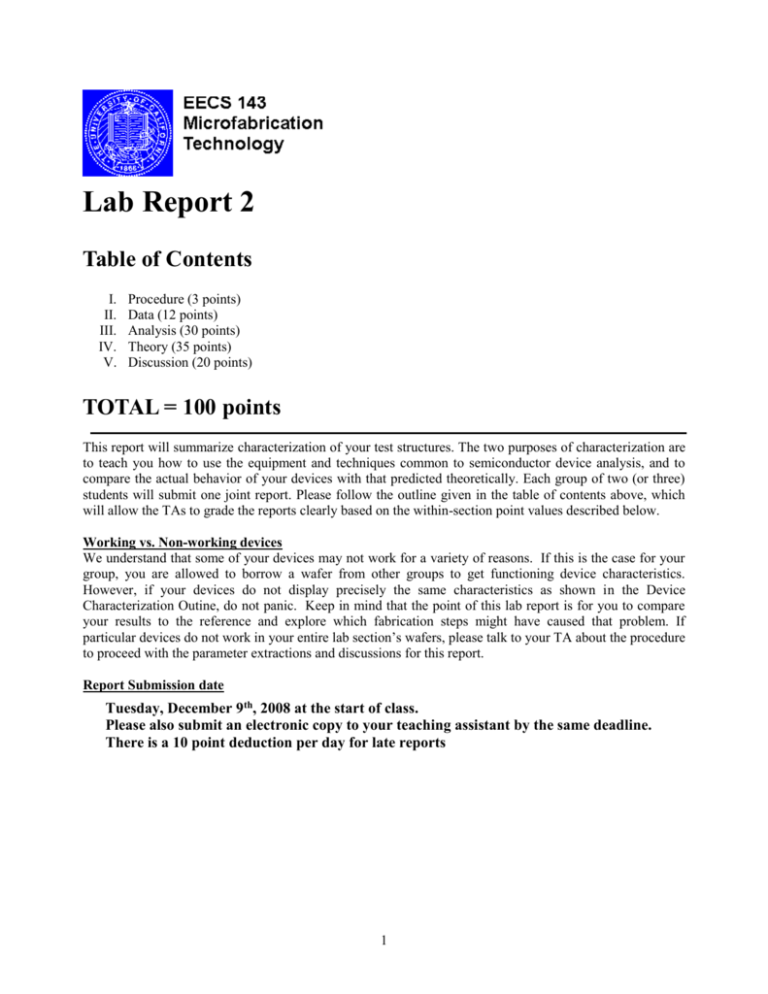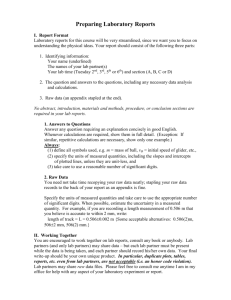Report 2 - EECS Instructional Support Group Home Page
advertisement

Lab Report 2 Table of Contents I. II. III. IV. V. Procedure (3 points) Data (12 points) Analysis (30 points) Theory (35 points) Discussion (20 points) TOTAL = 100 points This report will summarize characterization of your test structures. The two purposes of characterization are to teach you how to use the equipment and techniques common to semiconductor device analysis, and to compare the actual behavior of your devices with that predicted theoretically. Each group of two (or three) students will submit one joint report. Please follow the outline given in the table of contents above, which will allow the TAs to grade the reports clearly based on the within-section point values described below. Working vs. Non-working devices We understand that some of your devices may not work for a variety of reasons. If this is the case for your group, you are allowed to borrow a wafer from other groups to get functioning device characteristics. However, if your devices do not display precisely the same characteristics as shown in the Device Characterization Outine, do not panic. Keep in mind that the point of this lab report is for you to compare your results to the reference and explore which fabrication steps might have caused that problem. If particular devices do not work in your entire lab section’s wafers, please talk to your TA about the procedure to proceed with the parameter extractions and discussions for this report. Report Submission date Tuesday, December 9th, 2008 at the start of class. Please also submit an electronic copy to your teaching assistant by the same deadline. There is a 10 point deduction per day for late reports 1 Tips for writing your report 1. The objective of your report is to convince the reader of the following: You measured the data required. You plotted the data correctly. You extracted parameters from the plots. You carried out accurate calculations and gave a convincing discussion of how the results of these calculations differ from theory, and why. 2. Your lab report MUST follow the structure given below—even if you think you have a better plan for organizing your analysis, stick to ours so that we may grade your efforts fairly. Following the exact format will ensure fair grading. You will be deducted 5 points if you do not (within reason) follow the given outline. 3. Refer to the following documents on the lab website. They can answer most of your questions: Characterization Manual: http://www-inst.eecs.berkeley.edu/~ee143/fa05/lab/device_characterization.pdf Chip Layout http://www-inst.eecs.berkeley.edu/~ee143/fa05/lab/mems.html Process Flow: http://www-inst.eecs.berkeley.edu/~ee143/fa05/lab/NMOS-process-flow.pdf 4. MOST IMPORTANT: When things don't turn out perfectly, present a plausible explanation of why and where in the process, things went wrong. Also explain what should have happened and what you would have done. Do not fudge data. Well thought out explanations and insight into the problems in IC devices are worth more than perfect devices. 5. Unlike Lab Report 1, this report does not need to be paper-style. Do answer the questions in complete sentences and follow all instructions related to figures, tables, etc. 2 Report Sections: Title Page Include course name and number, semester, lab section and group number, member names, lab GSI's name, and professor's name. Please insert this grading rubric at the bottom: Part 1: Procedures Part 2: Data Part 3: Analysis Part 4: Theory Part 5: Discussion Total score /3 /12 /30 /35 /20 /100 Contributions In this section, you should list how each member contributed to each section of the report. Each group member should have at least some contribution to every section. Also, include the following academic honesty page near the front of your report. 3 EE143 Lab Report 2 - Fall 2008 In signing below, I attest to the fact that I have read and have adhered to the policies and guidelines discussed in the EECS Departmental Policy on Academic Dishonesty, as found at: http://www-inst.eecs.berkeley.edu/~ee143/fa05/policy.html Lab session: ___________________________________________ Signature: ____________________________ Name (Print) ____________________ (last) __________________________ (first) Department____________________________________________ Signature: ____________________________ Name (Print) ____________________ (last) __________________________ (first) Department____________________________________________ Signature: ____________________________ Name (Print) ____________________ (last) __________________________ (first) Department____________________________________________ 4 I. Procedures (3 points): The measurements you are responsible for taking and analyzing, are described in the Device Characterization page. For each of the major device types (resistor, contact-chain resistor, diode, MOSFET, inverter, and capacitors), include: (a) a top down picture of the device (b) a brief description of what stimulus was applied and what measurements were taken at each of the contact pads. Note that for the MOSFET, this will require at least two diagrams—one Id-Vds and one for Id-Vg you generated for each device. The diode will require two diagrams for forward bias and reverse bias. For example, the contact-chain resistor would look like: The drawings should be more heavily annotated that the ones in the lab manual, but otherwise, this section should be very brief. II. Data (12 points) For each of the required devices, extract the data and make plots of the relevant I-V or C-V curves. Please do not just paste your raw data from ICS metrics. You must correctly label axes and title each plot to specify the corresponding device number, and the measurement which you performed. For some devices, you should have more than one measurement. If you perform fits to your data in Part III, you may include them here in these plots for brevity Measurements are split up into 2 groups by the kind of electrical equipment required: 1. HP4155B: Semiconductor Parameter Analyzer: Required Devices: (15 Total DEVICES) [2a, 2b] Resistors: 1 plot each [total 2 plots] 5 [2c, 2c] Contact-Chain Resistors: 1 plot each [total 2 plots] [7] Diode: 1 plot-forward operation; 1 plot–reverse operation showing the breakdown region and breakdown voltage if measured [total 2 plots] [8a-d] MOSFETs of Varying Length: Id-Vds, Vg: 1 plot each [total 4 plots] Id-Vg, Vb: 1 plot each [total 4 plots] (Don’t forget that you need to take Id-Vd and Id-Vg sweeps for ten 8d devices for yield calculations. No need to show them here, though.) [9a-c] MOSFETs of Varying Width Id-Vds, Vg: 1 plot each [total 4 plots] Id-Vg, Vb: 1 plot each [total 4 plots] [10] Large Area MOSFET Id-Vds, Vg: 1 plot [total 1 plot] [11] Field Oxide MOSFET Id-Vds, Vg: 1 plot [total 1 plot] [14] Inverter [Vin vs Vout, Vdd] 2. HP4284A: Precision LCR Meter (1 station): EXPECTED total of 4 PLOTS Required Devices: (3 Total) [3] Field Oxide Capacitor [Total 1 Plot] [4] Gate Oxide Capacitor: Light On/Light Off [Total 2 plots] [5] Intermediate Oxide Capacitor [Total 1 Plot] 3. Measurement Issues Discuss the data obtained from any non-working devices. Only include this section if there are devices from which you can not extract parameters required in Part III. If the process was bad for your wafer and you used data from another wafer, explain why your devices did not work. (Please include representative plots above for your non-working devices, as well as the working devices from the other wafer.) III. Data Analysis (30 points) From the data taken above, find the following device parameters. Show all procedures and calculations or you will not receive credit. Include a circuit representation of the device (no circuit for line widths). To make life easier, follow the hints at the Device Characterization page 1. Line Width 2 pts Create a table of all measured line widths from each lithography step. This section can be copied over from lab report 1, if a thorough job was done. Pictures maybe provided for clarification in addition to reported values. You only need to provide one table: final line widths measurements after etching (photoresist line widths are acceptable) 6 2. Resistors (2a, b) 2 pts Extract the sheet resistance of each structure. Use line width data from Part 1 above to determine overetch/underetch and calculate the dimensions of the poly resistor, 2b. Calculate the sheet resistance for each structure. For diffused resistor 2a, use the junction depth value calculated in Lab Report 1 to determine the doping concentration and electron mobility from standard tables in Muller and Kamins. For the poly resistor 2b, calculate the polysilicon resistivity in (ohm-cm). [Hint: Polycrystalline Mobility is usually 10% of Crystalline, Why?] 3. Contact-chain resistors (2c, d) 2 pts Extract the resistance of each resistor. Calculate the contact resistance for the contacts of each structure, using the sheet resistance values from the previous calculations section (resistors). 4. Capacitors 8 pts [4] Gate Ox Cap: Extract the minimum capacitance (CDEP), both with lights on and off. Extract the flat band capacitance (CFB), flat band voltage (VFB). Extract the VTn Calculate the gate oxide thickness and C’ (capacitance / unit area) Calculate substrate doping concentrations. 5. Diode 2 pts Extract the turn-on voltage and the series resistance. 6. MOSFET 9c 14 pts Calculate the mobility (you can use I-V square law fitting). Extract Vt Yield: for the ten 8d transistors you measured, provide a table showing the mean, median, and standard deviation for each of the following device parameters. (Nonworking devices are valid here.) Note the actual “working” device yield as well. (12 pts) Ion (Vd at Vg = Vd = Vdd) Ioff (Vd at Vg = 0, Vd = Vdd) Ion/Ioff threshold voltage (Vt) IV. Theoretical Calculations (35 points) The theoretical values should be calculated totally independent of characterization measurements made in the second section of lab. You should use only values from report 1. Use the measured physical value of device dimensions and process parameters instead of the expected values in your theoretical calculations whenever you can. You need to use your earlier measured or extracted tox, Xj, 7 Nsurface and lateral diffusion (XjLateral) from the first lab report. At the beginning of this part, please list all of the measured physical value from your lab report 1. Provide this data in the form of a table. 6 pts Parameter Field tox Gate tox Intermediate tox XJ XJLateral NSurface Measured Value 1. Resistors (2a, b) 4 pts Using the thickness, junction depths and doping from report 1 determine the expected theoretical sheet resistance for both 2a and 2b. 2. Contact-chain resistors (2c, d) 4 pts Consult Jaeger’s section on contact resistance and report values for theoretical contact resistances that one would expect for devices 2c and 2d. 3. MOS Capacitors 13 pts Based on geometries defined in lab report 1, draw a schematic for the two capacitors mentioned below (the cross section) and label all pertinent capacitances. (2 points) Describe the physics of the MOS capacitor (what does MOS mean? Discuss the three regions of a MOS capacitor). Why does Intermediate Oxide Cap not display MOS effects? (3 points) Based on the geometries report the theoretical equations and plot the theoretical CV (as a function of bias voltage) for the following capacitors: o Gate Oxide Capacitor (you do not need to include photoelectric effect in your calculations but discuss expected photo electric effect, also calculate VTn and VFB) (8 points) 4. Diode: 2 pts Calculate the built in potential/turn on voltage for the pn junction. You can assume a step junction. 5. MOSFET 9c 6 pts Calculate the theoretical values for the MOSFET parameters listed in the table below. Use the empirically measured values of W/L from report 1. Determine the mobility as a function of the doping (Any EE130 textbook will have this). Calculate oxide capacitance from measurements of the gate oxide thickness in report #1. Calculate VTn (same as equations used for the MOS gate capacitor). V. Discussion (20 points) Fill in the master table with all of the measured values from the parameter extraction section, all the theoretical values from the theoretical calculations section, and the percentage difference between the two (three columns for each device parameter). You will lose points for this section if anything is left blank without explanation. 1. For each of the device parameters, discuss what may have caused the discrepancy (if any) between the measured and theoretical values. Present this in an organized and concise form using bulleted lists. Write only several sentences per point. Be concise, but thorough. (10 points) 8 For example: Device 2a: Diffused Resistor Discrepancy 1 and Reason 1 Discrepancy 2 and Reason 2 Device 2b: Poly Resistor Discrepancy 1 and Reason 1 2. Plot ideal square law MOSFET characteristics against one of the following MOSFETs: 8d, 9a or 10. Describe the non-ideal effects that can explain the differences between the two plots. (5 points) 3. Discuss reasons for the variations encountered in the 10 devices you measured for 8d. Discuss variations in each of the parameters and justify appropriate causes for these variations. (5 points) Summary of Device Parameters Device [2a] Sheet Res Units Ω/□ [2b] Sheet Res Ω/□ [2c] Contact Res cm-3 [2d] Contact Res cm-3 [4] Gate CFB F/cm2 Gate CMIN F/cm2 Gate VTn V Gate VFB V V Turn On V Rs (Series Res) kΩ [7] Parameter Measured/Extracted Theoretical % Error Summary of MOSFET Parameters Device [4] Parameter Units tox (gate) nm Cox (gate) F/cm2 ND (from 2a) cm-3 NA (from 2b) cm-3 [9c] eff cm2(V*s)-1 [9c] Vt Measured/Extracted 9 Theoretical % Error








